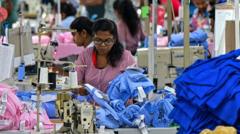Amidst impending tariff hikes, garment workers in Cambodia and Sri Lanka express fears of job losses that could worsen their families' existing financial struggles. As U.S. brands are heavily reliant on these countries for production, the new levies, set to begin shortly, may have disastrous consequences for the local economies and the livelihoods of millions.
Looming Tariffs Threaten Garment Workers' livelihoods in Asia

Looming Tariffs Threaten Garment Workers' livelihoods in Asia
As the U.S. prepares to enforce new tariffs, garment workers in Cambodia and Sri Lanka brace for devastating job losses.
The garment industry in Asia is facing an unsettling future as looming tariffs from the United States threaten the livelihoods of countless workers. With job security hanging in the balance, millions of garment workers in countries like Cambodia and Sri Lanka are bracing for the economic impact that will likely follow if a trade deal is not reached by the designated deadline.
The warning shot was fired on July 9 when the U.S. president announced new tariffs to commence on August 1, following a 90-day negotiation period which provided a temporary reprieve. Although the new rates are slightly reduced from what was proposed earlier, anxiety abounds as countries such as Cambodia and Sri Lanka brace for significant financial repercussions. Under the new guidelines, tariffs will reach as high as 36% for Cambodia and 30% for Sri Lanka—countries that have built robust garment sectors reliant on the US market for exports.
For many workers, like Nao Soklin, a factory employee in Cambodia, the implications are personal and dire. "Can you imagine what will happen if [we] lose our jobs? I'm so worried, especially for my kids. They need food," she confided in an interview. In her ten-hour workday sewing bags, Soklin and her husband collectively earn approximately $570 a month, just enough to support their family of four. She implores, “We need our jobs to support our families."
The stakes are equally high for Sri Lanka, where garment exports have surged to $1.9 billion, directly employing around 350,000 workers. Yohan Lawrence of Sri Lanka's Joint Apparel Association Forum cautions that if tariffs remain high, the country risks falling behind competitors like Vietnam, which benefit from lower tariffs.
In a desperate bid to mitigate the impending financial fallout, both Cambodia and Sri Lanka have engaged in negotiations to lower the anticipated rates. The Cambodian administration has reported slight concessions in the initial tariff proposals, and its Deputy Prime Minister expressed a commitment to continue advocating for more favorable terms.
Trump, however, justifies the tariffs as a necessary measure to address trade imbalances, stating that the existing arrangement has often favored other nations. Yet, experts argue that such tariffs can produce the unintended consequence of harming both economies. By discontinuing favorable trade terms that had fostered these nations’ garment industries, critics suggest the U.S. will undermine its own benefits from cheaper exports and sustained profits.
Currently, workers confront simultaneous challenges, such as poverty and inadequate labor rights, exacerbated by the U.S. tariffs. Approximately 70% of garment workers in these regions are women, who already experience significant wage struggles. With potential layoffs looming, their families face an uncertain future.
"We pray every day that President Trump will lift the tariff," remarked An Sopheak, a clothing worker in Cambodia, underscoring the gravity of their predicament. While some concurrently cast their gaze toward Thailand seeking alternative employment, the sentiment remains bittersweet, with many fearing the worst as their livelihoods hinge on what happens next.
As the clock ticks down, these garment exporters navigate a precarious landscape influenced by shifting trade policies and global competition, all while the fates of thousands hang in the balance.

















